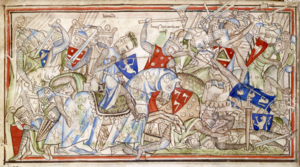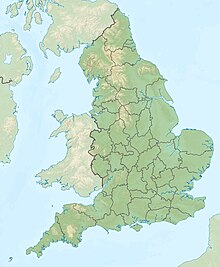
Back معركة جسر ستامفورد Arabic استمفورد بریج دؤیوشو AZB Битка при Стамфорд Бридж Bulgarian Emgann Stamford Bridge Breton Batalla de Stamford Bridge Catalan Bitva u Stamford Bridge Czech Brwydr Pont Stamford Welsh Slaget ved Stamford Bridge Danish Schlacht von Stamford Bridge German Μάχη του Στάμφορντ Μπριτζ Greek
| Battle of Stamford Bridge | |||||||
|---|---|---|---|---|---|---|---|
| Part of the Viking invasions of England and the Norman Conquest | |||||||
 | |||||||
| |||||||
| Belligerents | |||||||
| Kingdom of England |
| ||||||
| Commanders and leaders | |||||||
| Strength | |||||||
|
| ||||||
| Casualties and losses | |||||||
| 5,000[1] | 6,000–8,000+ dead or missing[2][3] | ||||||
Location within England | |||||||
The Battle of Stamford Bridge (Old English: Gefeoht æt Stanfordbrycge) took place at the village of Stamford Bridge, East Riding of Yorkshire, in England, on 25 September 1066, between an English army under King Harold Godwinson and an invading Norwegian force led by King Harald Hardrada and the English king's brother Tostig Godwinson. After a bloody battle, both Hardrada and Tostig, along with most of the Norwegians, were killed. Although Harold Godwinson repelled the Norwegian invaders, his army was defeated by the Normans at Hastings less than three weeks later. The battle has traditionally been presented as symbolising the end of the Viking Age, although major Scandinavian campaigns in Britain and Ireland occurred in the following decades, such as those of King Sweyn Estrithson of Denmark in 1069–1070 and King Magnus Barefoot of Norway in 1098 and 1102–1103.
- ^ "The Battle of Stamford Bridge, 1066".
- ^ Cite error: The named reference
Anglo-Saxon Chronicles, p. 199was invoked but never defined (see the help page). - ^ While the initial invasion force required 300 longships to carry 10,000 troops (Jones, Charles (2011). Finding Fulford. London: WritersPrintShop. pp. 202–203), only 24 ships, or 8% of the fleet, were needed to carry back the survivors after Stamford Bridge ("Anglo-Saxon Chronicles", p. 199).
© MMXXIII Rich X Search. We shall prevail. All rights reserved. Rich X Search
